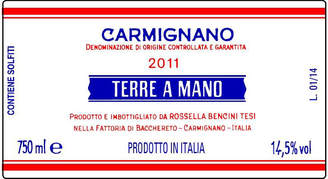Fattoria di Bacchereto has a story with more significance in the wine world than most all others in the world. Carmignano DOCG was the first region to receive established rules regarding wine production in 1716 by the Grand Duke Cosimo III; making it Italy's first 'DOC' (100 years prior to any AOC regulations in France!), known as Barco Reale. Bacchereto's estate was part of the old Barco Reale game reserve for the Grand Duke in 1626, which has since become noted for its wine production. As the Rosella Bencini Tesi family first took over the property in 1920, they were already destined to produce incredible fruit, and now farm 8 hectares of grapes within 9 different parcels, and have 60 hectares of olive trees and woods in the famous forests of the region. In 2002 the 'Terre a Mano' name was added to the winery to signify their commitment to the natural methods they use in all aspects of their production; including biodynamic practices, minimal intervention with the wines, and making not only traditional Carmignano Rosso, but also incredible skin-fermented white wine, and some of the loveliest Vin Santo one can find.
terre a mano carmignano
75% sangiovese, 15% canaiolo, 10% cabernet sauvignon
The Terre a Mano Carmignano is a traditional blend for the region, having predominately Sangiovese as the focal point, some native Canaiolo, and a bit of Cabernet Sauvignon (which has been part of the Carmignano regulations since it began 300 years ago) which is still sometimes called Uva Francesca. All of the fermenting grapes, and even vineyard sites and plots, are kept separate from each other until the very end when the time comes for blending and bottling. Natural alcoholic fermentation takes place in concrete vats. Once complete, the juice is moved to used French Tonneau for spontaneous malo-lactic fermentation to begin, and is then racked when finished. The wine rests for close to two years in barrel before it is blended back into concrete (which is the first time the juice sees any sulfur addition), and mellows for another 2-3 months before bottling. And the finished wine is full of vibrant acidity, fresh fruit, balanced oak influence, and fantastic tannins. It is the original ‘Super Tuscan.’
